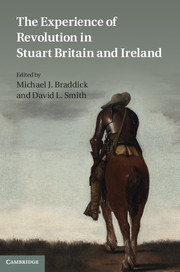Book contents
- Frontmatter
- Contents
- Notes on contributors
- Preface
- List of abbreviations
- JSM
- Introduction: John Morrill and the experience of revolution
- 1 The Scottish–English–Romish Book: the character of the Scottish Prayer Book of 1637
- 2 Popery in perfection? The experience of Catholicism: Henrietta Maria between private practice and public discourse
- 3 Sir Benjamin Rudyerd and England's ‘wars of religion’
- 4 Rhetoric and reality: images of Parliament as Great Council
- 5 Cathedrals and the British Revolution
- 6 History, liberty, reformation and the cause: Parliamentarian military and ideological escalation in 1643
- 7 Sacrilege and compromise: court divines and the king's conscience, 1642–1649
- 8 Law, liberty, and the English Civil War: John Lilburne's prison experience, the Levellers and freedom
- 9 On shaky ground: Quakers, Puritans, possession and high spirits
- 10 James Harrington's prescription for healing and settling
- 11 ‘The Great Trappaner of England’: Thomas Violet, Jews and crypto-Jews during the English Revolution and at the Restoration
- 12 The Cromwellian legacy of William Penn
- 13 Irish bishops, their biographers and the experience of revolution, 1656–1686
- 14 Religion and civil society: the place of the English Revolution in the development of political thought
- Bibliography of the major writings of John Morrill, 1967–2009
- Index
- References
5 - Cathedrals and the British Revolution
Published online by Cambridge University Press: 05 August 2011
- Frontmatter
- Contents
- Notes on contributors
- Preface
- List of abbreviations
- JSM
- Introduction: John Morrill and the experience of revolution
- 1 The Scottish–English–Romish Book: the character of the Scottish Prayer Book of 1637
- 2 Popery in perfection? The experience of Catholicism: Henrietta Maria between private practice and public discourse
- 3 Sir Benjamin Rudyerd and England's ‘wars of religion’
- 4 Rhetoric and reality: images of Parliament as Great Council
- 5 Cathedrals and the British Revolution
- 6 History, liberty, reformation and the cause: Parliamentarian military and ideological escalation in 1643
- 7 Sacrilege and compromise: court divines and the king's conscience, 1642–1649
- 8 Law, liberty, and the English Civil War: John Lilburne's prison experience, the Levellers and freedom
- 9 On shaky ground: Quakers, Puritans, possession and high spirits
- 10 James Harrington's prescription for healing and settling
- 11 ‘The Great Trappaner of England’: Thomas Violet, Jews and crypto-Jews during the English Revolution and at the Restoration
- 12 The Cromwellian legacy of William Penn
- 13 Irish bishops, their biographers and the experience of revolution, 1656–1686
- 14 Religion and civil society: the place of the English Revolution in the development of political thought
- Bibliography of the major writings of John Morrill, 1967–2009
- Index
- References
Summary
The British Revolution began and ended in a cathedral. The first act of violence of the three kingdoms' civil wars was the famous riot in St Giles's cathedral, the High Kirk of Edinburgh, on 23 July 1637, in protest at the first reading of the Scottish Prayer Book. The symbolic end of the Revolution came on Sunday 27 May 1660, the first church service that Charles II attended after his return to any of his kingdoms: in Canterbury cathedral (albeit ‘very much dilapidated and out of repair’) and using the Book of Common Prayer, episcopalian church and crown symbolically reunited. For many others in the three kingdoms, the Revolution did not end so neatly; nonetheless, across all three kingdoms, from Winchester to Dublin to Aberdeen, the restoration of monarchy and church was marked and celebrated in cathedrals or their sister institutions, collegiate churches, or by the remnants of cathedral choirs. The resumption of choral services and episcopal ceremony in a cathedral was an important marker of the restoration of monarchy.
Cathedrals framed the British Revolution because there had been considerable unease as to their purpose, even their existence, since the Reformations of the mid-sixteenth century. Cathedral and collegiate churches, with their choirs of priests, laymen and boys, had been established for the ceaseless round of Catholic devotion; what role could they have in a Protestant church where the Word of God was supreme?
- Type
- Chapter
- Information
- The Experience of Revolution in Stuart Britain and Ireland , pp. 96 - 116Publisher: Cambridge University PressPrint publication year: 2011
References
- 2
- Cited by



